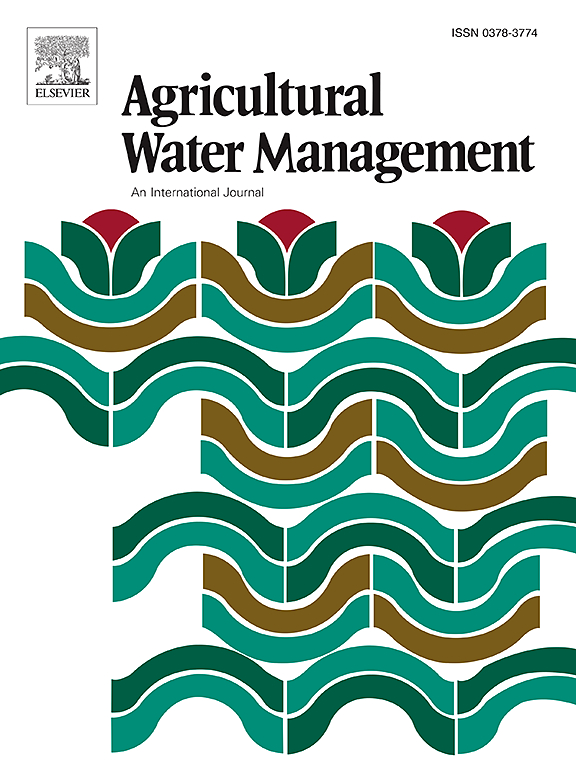Enhancing rice yields, water productivity, and profitability through alternate wetting and drying technology in farmers’ fields in the dry climatic zones of West Africa
IF 5.9
1区 农林科学
Q1 AGRONOMY
引用次数: 0
Abstract
Irrigated rice farming is crucial for meeting the growing rice demand and ensuring global food security. Yet, its substantial water demand poses a significant challenge in light of increasing water scarcity. Alternate wetting and drying irrigation (AWD), one of the most widely advocated water-saving technologies, was recently introduced as a prospective solution in the semi-arid zones of West Africa. However, it remains debatable whether AWD can achieve the multiple goals of saving water while increasing yield and farmer income in diverse edaphic and climatic growing environments. We carried out participatory on-farm trials in four major irrigation schemes of Burkina Faso, (i) to assess the effects of AWD on yield, water productivity, and profitability in comparison to farmers’ irrigation practices, and (ii) to identify the environmental conditions and cropping practices determining yield gain of AWD over farmers’ irrigation practices. During the 2018 and 2019 wet and dry seasons, we conducted 154 pairwise comparisons of AWD at the threshold of 15 cm below the ground surface, and farmers’ irrigation practices (fields being submerged as frequently as water availability allowed according to the scheme-dependent water provision schedule). The drivers of yield gains associated with AWD were identified using brute force and random forest machine learning algorithms. Across irrigation schemes and seasons, AWD reduced irrigation water input by 30 %, while increasing grain yield by 6 % (p < 0.05). Consequently, AWD increased the irrigation water productivity by 64 % and profit by 5 % over farmers’ irrigation practices. The AWD-associated yield gains were higher in fields with poor access to irrigation water, and higher for indica than for tropical japonica varieties. Overall, AWD appears to be an effective strategy to improve yields, water productivity, and profitability in rice irrigation schemes in dry climatic zones in West Africa. This study suggests a need for reshaping rice irrigation practices, involving a systematic monitoring of field water levels in the region.
通过在西非干旱气候区农民的田地里交替使用湿润和干燥技术,提高水稻产量、水分生产率和盈利能力
灌溉水稻种植对于满足日益增长的水稻需求和确保全球粮食安全至关重要。然而,在水资源日益匮乏的情况下,水稻的大量用水需求构成了巨大挑战。干湿交替灌溉(AWD)是最广为提倡的节水技术之一,最近被作为一种有前景的解决方案引入西非半干旱地区。然而,干湿交替灌溉能否在不同的自然和气候生长环境中实现节水、增产和农民增收的多重目标,仍有待商榷。我们在布基纳法索的四个主要灌溉计划中开展了参与式农田试验,(i) 评估与农民灌溉方式相比,AWD 对产量、水生产力和盈利能力的影响,(ii) 确定决定 AWD 比农民灌溉方式增产的环境条件和种植方式。在 2018 年和 2019 年的雨季和旱季,我们对地表下 15 厘米阈值的 AWD 和农民的灌溉方式(根据计划供水时间表,在水量允许的情况下尽可能频繁地淹没田地)进行了 154 次配对比较。使用蛮力和随机森林机器学习算法确定了与AWD相关的增产驱动因素。在不同灌溉方案和季节,AWD 减少了 30% 的灌溉水投入,同时增加了 6% 的谷物产量(p < 0.05)。因此,与农民的灌溉方式相比,AWD 提高了 64% 的灌溉水生产率和 5% 的利润。在灌溉条件较差的田块,AWD 带来的增产幅度更大,籼稻品种的增产幅度也高于热带粳稻品种。总之,在西非干旱气候区的水稻灌溉计划中,AWD 似乎是提高产量、水生产力和利润率的有效策略。这项研究表明,有必要重新调整水稻灌溉方法,对该地区的田间水位进行系统监测。
本文章由计算机程序翻译,如有差异,请以英文原文为准。
求助全文
约1分钟内获得全文
求助全文
来源期刊

Agricultural Water Management
农林科学-农艺学
CiteScore
12.10
自引率
14.90%
发文量
648
审稿时长
4.9 months
期刊介绍:
Agricultural Water Management publishes papers of international significance relating to the science, economics, and policy of agricultural water management. In all cases, manuscripts must address implications and provide insight regarding agricultural water management.
 求助内容:
求助内容: 应助结果提醒方式:
应助结果提醒方式:


